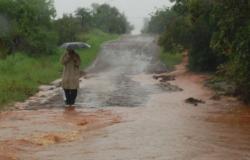Indigenous people participate in an event where the Colombian government apologized to four indigenous peoples of the Amazon (Uitotos, Bora, Okaina and Muinane) for the violence of which they were victims during the dark years of the rubber fever that put them on the brink of extermination. to those communities this Tuesday, in La Chorrera, Amazonas.
Photo: EFE – Mauricio Dueñas Castañeda
The Colombian government issued an official apology last Tuesday, April 23, to the indigenous communities of the Amazon for the horrors suffered during the period known as the “rubber rush” in the 19th and 20th centuries. In a ceremony that took place at the historic Casa Arana, the Minister of Cultures, Juan David Correa, recognized the abuses committed against indigenous peoples, including the murder of some 60,000 indigenous people and the slavery imposed by the rubber industry.
This is an initiative that has been carried out by the national government, headed by the Ministry of Cultures, Arts and Knowledge, which seeks the reparation of the indigenous communities of the Amazon. Last Thursday, April 11, the commemoration agenda for the centenary of the publication of La Vorágine, an emblematic work by José Eustasio Rivera, began in Mocoa, Putumayo. During the event, Minister Correa apologized to the indigenous communities of the region for the horrors experienced during the rubber boom in the 20th century, recognizing the historical debt that the country owes to the Amazonian peoples. The event was attended by representatives of various indigenous peoples, as well as local and national authorities.
In this case, in the commemoration of the creation of the Putumayo Predio Resguardo, established in 1988, indigenous people from various towns, including the Uitoto, Bora, Ocaira and Muinane, received the government representation with songs and typical costumes in a nearby field. to the hacienda that belonged to Julio Arana, located on the triple border between Colombia, Brazil and Peru.
Minister Correa denounced the “rubber horror” that was experienced in the region, where nine indigenous peoples were finally restored to their lands by the Colombian State during the government of Virgilio Barco.
The “regime of terror” associated with rubber exploitation lasted until the beginning of the 20th century and was immortalized in the film “The Embrace of the Serpent” by Ciro Guerra. The Colombian government has called these events a “genocide” in the Amazon, marked by forced labor, torture, famine and epidemics caused by terrible living conditions.
The official visit coincides with the cultural agenda around the centenary of the publication of The Maelstrom by José Eustasio Rivera, a literary work that exposes the abuses suffered by indigenous people during the rubber fever.
Ángel Cerayitoga, leader of the local indigenous peoples, noted that “There are still many things that have not been written about what happened within the framework of Casa Arana.”
Julio César Arana, a Peruvian businessman, was a key figure in the expansion of the rubber industry in the region. His company, the Peruvian Amazon Company, financed by English capital, operated in what are now the territories of Peru, Colombia and Ecuador. The crimes associated with his land expansion led Arana to appear before the British Parliament in 1913, where he partially admitted responsibility following an investigation led by Britain’s consul in Rio de Janeiro, Roger Casament.
“Today we must look them in the eyes and ask for their forgiveness. “Western society, the settlers, the businessmen (…) were cruel against you, against your people,” said the Minister of Culture in the symbolic Casa Arana, one of the main rubber collection centers at the time.






